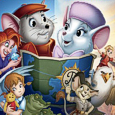Walt Disney Pictures (June 22 1977), Walt Disney Home Entertainment (May 20 2003), single disc, 76 mins plus supplements, 1.66:1 anamorphic widescreen, Dolby Digital 5.1 Surround, Rated G, Retail: $19.99
Storyboard:
Set in the bustling city of New York, as well as the backwater swamps of Devil’s Bayou, The Rescuers introduces us to two courageous little mice, Bernard and Miss Bianca. Bianca is an agent for The Rescue Aid Society, a secret rodent organization that helps those bigger than themselves out of danger. When a message in a bottle is found, Bianca volunteers to go and help the sender, a young girl named Penny, on the basis that janitor Bernard is made her co-agent, something that he, being fond of Bianca, is more than happy to agree with! Soon they’re off on the back of Orville the airline albatross, soaring towards the Bayou where Penny is being held captive by the twisted, and not altogether sane, Madame Medusa. She has Penny locked up so as to use the girl to fit down a teeny-sized cave and retrieve the legendary Devil’s Eye – the biggest diamond in the world! The two mice arrive in time to help Penny and find the diamond, but Medusa and her sneaky assistant Snoops prove that they’ll stop at nothing in order to keep the diamond from escaping their clutches…
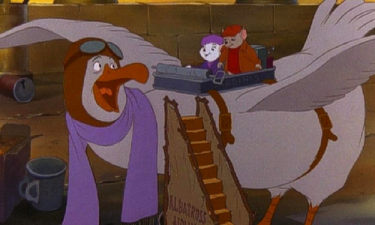
The Sweatbox Review:
Disney’s 1977 animated feature finally gets a digital makeover and arrives looking fresh, if not totally clean, on DVD. A strange title to pigeonhole in the overall Disney scheme of things, the film came right in the midst of the “middle-Disney” period between Walt’s passing and the management takeover of 1984. Traditionally in home video terms the film has often been the last one to be announced or released on any format, coming late in the game on VHS and LaserDisc. When the movie was finally issued on those formats, it was from a later re-issue print and all seemed okay. However, a later pressing, taken from the original release prints, revealed a now famous in-joke from the background artists – the inclusion of a nude painting in one of the windows that a character flies by during an air trip. Only on-screen for two frames, and barely noticeable at that, even at freeze frame, it was enough to prompt Disney to recall the release, with only a handful of early buyers (and lucky laser owners) holding on to their copies (me included)!
Whether or not this has anything to do with why The Rescuers is always “late to the ball” is unknown, but this great little film really does deserve more, especially as it came at a time when the animation division needed a hit and was luckily rewarded with this blockbuster (it remains the only classic with a narrative story to have had a theatrically released sequel produced by the Feature Animation team). It’s also the first Disney animated film I saw in a movie theater and as such has become somewhat of a favorite over the years. And now we can finally add The Rescuers to our region one collections, but don’t start the celebrations just yet…

As mentioned above, The Rescuers is often overlooked, both by fans and by the Studio. By the time of the film’s release the Studio had lost its way a little, trying to come up with projects that Walt might have made. A fine enough thought, but Walt was always progressing and changing with the market, more often than not actually leading the market! The creation of the adult-orientated Touchstone Films in 1983 would go some way to restoring box office glory to the Studio, but in the 1970s, everything was either kids-in-trouble adventures or fantasy-comedy territory, something that the Studio was known for, but also ridiculed. The live-action films from this time (and I do count myself as a big fan of most) were by-the-numbers comedies, with not-so-special effects, and felt like a continuation of the 60s family films that the company produced, though with a new “funky” sensibility in their bass-guitar and Hammond organ-led music scores.
In the animation department, the first film to go into production after Walt’s last, The Jungle Book, was Ken Anderson’s The AristoCats, which Anderson had proposed to Walt and for which he was personally given the go-ahead. The film proved a hit (especially in France) and main vocal talent Phil Harris was brought back for a third time (after Jungle Book) to reprise his “big bear” role as Little John in the unit’s next feature Robin Hood. A clever and intriguing concept – the legend of the Merry Men as depicted by animals, a “Merry Men-agerie” as the posters proclaimed) – was a fun knockabout comedy, with moments of great pathos, but more often than not, the feeling of an old English pantomime. There was also no through story, with the result that the plot felt very episodic.
Perhaps feeling dried up, the Studio began its new animation training program, which brought in a new generation of artists full of new ideas. After a few quiet years, the Studio bounced back in 1977 with three features: The Many Adventures Of Winnie The Pooh, a compendium of the three Pooh featurettes that had originally been intended as a feature; Pete’s Dragon, another live-action/animation musical combination that, as with the Studio’s Bedknobs And Broomsticks, had a less than stellar post-Mary Poppins reception at the box office; and The Rescuers. The Pooh film had been a moderate success, bringing in a new audience for A.A. Milne’s characters, but Dragon had been no less Candle In The Water as pretty much dead in it, and the animators were still under scrutiny. Returning to animated mice (always lucky for the Disney company!) their new film had to live up to high expectations. Thanks to a tight storyline, contemporary setting and wide scope the aptly named The Rescuers delivered and put the company back on track.
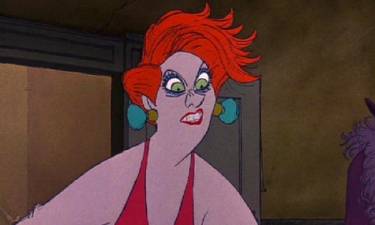
In a day and age when new animated films proudly claim that they don’t have any songs within the score to slow things down, many forget that The Rescuers pioneered the use of songs on the soundtrack as opposed to having the characters actually mouthing the words. Another recently broken “rule”, that animated films don’t usually have their voice casts revealed in advertising, was also abandoned here, with original release posters for the film proudly announcing it’s then-hot cast of Bob Newhart as Bernard and Eva Gabor (playing another slinky Disney character after Duchess in The AristoCats) as Bianca. The voice cast is top-notch and all the performers perfectly fit their roles. Equally as good as the leads is Geraldine Page as Medusa, putting her all into the character and distinguishing her enough from the similar Cruella De Vil, with whom she could be related (early concepts show that Cruella was in fact down to “star” as the villainess in the film).
Many critics’ views against The Rescuers are aimed at the animation in the film. Although a big hit at the time, The Rescuers was produced on an extremely tight budget, something that might have damaged the timeless nature of the production and possibly dates the picture. Certainly in production the artists were complaining that corners were being cut: it was a supervisor that advised young animator Don Bluth not to bother coloring the whites of Bernard’s eyes that finally tipped the scales and contributed to his walkout along with several other new talents. In fact The Rescuers does feature some outstanding scenes, and has a very dramatic look to it, particularly in the swamp moments with Evinrude trying to outrun Medusa’s evil crocs Brutus and Nero. This is down to Woolie Reitherman’s direction, here sharing with Art Stevens and John Lounsbery, and Artie Butler’s careful and almost live-action use of music, which never “Mickey Mouses” the action.
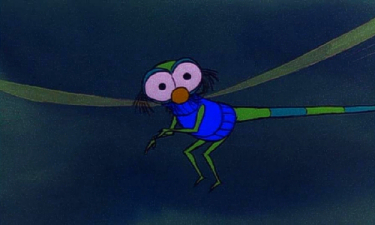
The entire film looks and feels quite dark at times, and there are some bold choices that wouldn’t get past the over cautious at Disney nowadays, not least the child kidnap plot and Medusa’s forcing Penny into the cave (“You get down there and find the big diamond or you’ll never see your Teddy again!”). And can you see the scene where Medusa actually aims and fires her shotgun at the young girl making it into a modern Disney film? Even Spielberg shied away from that in his revised edition of ET. This is however what makes the film work. That Penny is an orphan sets her up as an even more sorrowful character that needs rescuing in more ways than one, while the lengths that Medusa will go to places her in real danger. As an audience member, one also has to wonder what will become of Penny once Medusa has what she wants.
On the flipside, there are several heart warming scenes, such as when the two brave mice meet Rufus the orphanage cat, and the Oscar-nominated Someone’s Waiting For You sequence, as well as the pure excitement and suspense of the ride through the swamp with Evinrude, and Bianca’s own rescue from the water. There are some cost cuts that will stand out to long time Disney fans: Medusa’s getaway in her car will again hark back to Cruella’s chasing the puppies, and some recycling of material from Bambi may seem familiar. This is the real transitional film that bridges the gap between Walt’s original “Nine Old Men” and the new generation of artists, among them Glen Keane, Ron Clements, Andy Gaskill, and the Bluth team of Gary Goldman and John Pomeroy, and it’s great to be able to see how far these talents had come on by the time of the 1990 sequel The Rescuers Down Under.
The choice of the voice cast, again as with The Jungle Book and Robin Hood chosen for their personalities as well as their acting ability, helps give the feeling of truly dimensional characters that need no introduction: we know exactly who they are when we first meet them, a fact that was noticed by the critics of the time of the film’s initial release. The little touches in the backgrounds are fun too, such as the normal-sized everyday human objects that have been redesigned and implemented in the mouse world (the Mickey Mouse watch used as a clock on the wall of the Rescue Aid Society, which resides in the basement of the United Nations, for instance). There is also some solid color concepts going on in the backgrounds, and it is clear that attempts to get away from the stylised layouts of the 1960s were being made. Some are great and pre-empt the use of CGI for various props, such as the escalator that the mice take to the top of the airport lounge, or the light changes underneath the helipad, while others (the sea during the “journey” sequence) may seem flat to first timers.
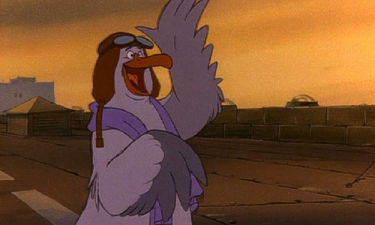
At the end of the day, The Rescuers has been overlooked for far too long. This pretty quiet disc release won’t change that attitude, but may catch a few interested viewers by surprise and will hopefully engage the kids of today. The sequel adds some zip-whizz CGI to the mix, but plays as simply as this first film: a straightforward and enjoyably animated adventure that will thrill you and make you laugh. Perfect family fare, with enough invention to delight anyone in the room.
Is This Thing Loaded?
The Rescuers comes to DVD as neither a Gold Collection nor Special Edition release, but does feature a few surprises, as well as some mediocre offerings. First up, on playing the disc, are the usual flow of Sneak Peeks we’ve come to expect. Skippable, and viewable again from the main menu, the previews here are for The Lion King Platinum, Air Bud Spikes Back (surely this series is in double figures by now?), Jungle Book 2, Piglet’s Big Movie, Stitch! and Sleeping Beauty’s almost-Platinum edition. Although the disc’s logos and menus are all anamorphically encoded, the previews play in 4:3 fullscreen, or non-anamorphic letterboxed widescreen.

One nice touch is to have Evinrude fly past to switch between menus, and from the main one the option for Bonus Features reveals what The Rescuers has to offer. Getting the once-viewed-best-left-forgotten extras out of the way first, we have The Ultimate Case game, wherein the player must find the clues to help Penny solve a mystery. Not terribly exciting, the game will improve younger kids’ search and recognise skills, but the game offers no reward other than confirmation that the player has successfully become a full member of the Rescue Aid Society.
The Someone’s Waiting For You sing-along offers the chance to hear the Oscar-nominated song from the movie again, with the words intact on screen, so as kids can try and keep up with the lyrics. Adults and fans might want to check out the video quality to see what the pre-remastered edition looked like – not a pretty sight! Another eminently throwaway inclusion is Under The Hat Villains, which looked like it might be a fun featurette on all those classic Disney sourpusses we love to hate. Alas, it’s simply a promo culled from the Toon Disney channel, running a bare 90-seconds or so and just briefly touching on several blink-and-you’ll-miss-’em shots of various bad guys and gals from the classics. Best parts are quick soundbites from Andreas Deja and Randy Haycock explaining their angles on what makes a good villain tick, but it’s a generic piece that doesn’t really belong anywhere.
The first of the more meaty extras (though don’t go expecting a full meal here!) is The Rescuers Scrapbook, designed in the same way that previous “scrapbooks” have appeared on Gold Collection and Special Edition releases of titles such as The Black Cauldron and Oliver And Company. Here you’ll find 15 pages of full-framed images ranging from early concepts (with some very interesting alternate production designs), through character development (including an early Cruella-wearing-crocskin-coat picture) and behind the scenes production and voice-artist stills, to premiere and publicity artwork (one of which refers to the film as The Rescuers At Devil’s Bayou). Not as extensive as the double-disc sets, but more than reasonable and in keeping with Disney’s secondary releases.

Onto the video based extras, and a cartoon that seems to be included only as it stars mice, three to be exact, in the 1936 Silly Symphony Three Blind Mousketeers. Now I’ve seen this short so many times that I was weary of sitting through it again, but this new color transfer puts past releases to shame, although the print is not as clean as the cartoons that turned up in the Symphonies Treasures tin set. The exquisitely detailed cartoon follows the three blind mousketeers’ attempts to outwit a Black Pete-type and grab some of his food, but packs in a great deal of fun and some terrific light and shadow effects. Presented in its original 1.33:1 and running almost ten minutes, this is probably the most fun extra on the disc, which isn’t saying much when one realises that this is sure to turn up elsewhere.
No less a surprise, but not quite as enjoyable as the cartoon, is the addition of a 31 minute full-length True Life Adventure film, Water Birds, from 1952. Narrated by Winston Hibler, the film (photographed by 16 cameramen) has a nice segue from an animated paintbrush to the live-action footage, but the dry voice over and quite frankly appalling print will make this unwatchable for most kids, let alone those hungry for any of the Adventures on DVD. It looks like a college campus 16mm copy that has been dragged through one too many wildlife classes. Those able to see through the speckled image will surely be entertained enough and this is most certainly amazing footage, especially considering that these films pioneered the stunning “life on Earth” documentaries of today.
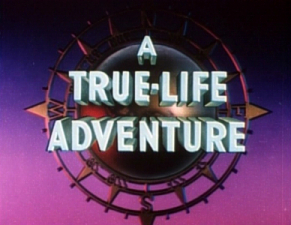
The True Life Adventures opened up a whole new world of entertainment – our own – and were brought to life through the magic of motion pictures by Walt’s ability to tell a good story. Hibler’s narration fashions together a plot of sorts, aided by Paul Smith’s vibrant and energetic musical score (ending with a bombastic rendition of Listz’s Hungarian Rhapsody, a cartoon favorite). This is true life the Disney way although it does not shy away from the animals’ natural instinct and feeding habits. But I must say that I hope in the set of these films making their way to disc soon this particular title looks a lot better than it does here.
Well, there you have it. There’s little that ties to the actual main feature, and as usual the theatrical trailer is MIA, as are any DVD-ROM additions (it seems The Devil’s Eye diamond is not all that Medusa has stolen as there’s only a link to register your DVD). The cartoon and the True Life Adventure seem only to have been included due to the similarities in the types of animal seen in the film itself, but the Scrapbook at least offers some slight insight into the making of the film, often with previously unseen images.
Case Study:
Well, well, what’s this? On opening the cover, which is based on the previous home video and LaserDisc release artwork right down to the tagline, I found that my copy did not contain a chapter insert. Now I know that some studios do not always include them, and the Disney inserts have been a bit of a hit-and-miss affair in terms of their page-size and design, but dropping them completely is a big no-no in my book – not impressed.
Ink And Paint:
Compared to the recalled, second-release LaserDisc, which I managed to blag a copy of last-minute, I could see no real difference between that print and this “new remaster”, except for the anamorphic enhancement. Presented in 1.66:1 widescreen, the first obvious change is the deletion of the LD’s Buena Vista distributor logo, which has been replaced by the traditional Walt Disney Pictures fairy-tale castle ident. These first few seconds of film look terrible, and at first I thought we might be in for simply a widescreen version of the very old original video master. I was relieved to find that the film settles down immediately after this into a fairly clean and steady edition of the movie. While not as extensively restored as the wider released Disney classics, there isn’t too much to complain about here, although minor print marks and scratches come and go throughout. There’s no doubt that The Rescuers could look much cleaner than this, but any lack of resolution in the image is more often due to the production techniques employed in the actual production of the movie than any authoring discrepancies.
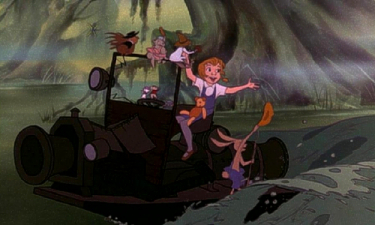
Scratch Tracks:
Supposedly given a new 5.1 surround mix, I noticed little difference initially between the original mono LD and this disc. Dialogue of course remains locked to the center speaker and this sounds crisp and clear as expected. The music has the biggest effect in this new mix, spreading to the left and right, while only a small amount of bleed to the rears brings out the ambient surround atmospheres. However overall there really isn’t much difference between the original track and the new mix and the LFE channel (the “.1”) doesn’t get as much of a work out as you might expect. Things still seem compressed in the mid-range (apparently inherent in the originally recorded tracks), but everything is understandable and enveloping enough. Well-recorded French and Spanish language dubs are included, both well up to the usual high Disney standards.
Final Cut:
Some stockists had trouble ordering this title from Disney, despite the fact that copies of lesser films and DTV fare such as the Atlantis and Jungle Book sequels seem available in abundance. Disney really should treat their animated classics with more pride, even their so-called secondary titles. The Rescuers is a fairly important film that saved the animation division back in 1977 and, if handled right, could launch another franchise for the Studio (where IS the Bernard And Bianca TV series of adventures?). That they choose to favor and promote a lacklustre sequel and the few episodes of a doomed television series over a little gem like this is a shame, especially when they have a built in audience of original fans and those who probably saw the 1990 sequel before this first film. Even sold as a “new” direct to video film, the company would have made a better profit on this title, rather than the below average figures they are already probably expecting.
As I’ve mentioned in other reviews, not all titles deserve or even need the full 2-disc Special Edition treatment, though The Rescuers does deserve more than this, in both the disc and its general recognition. It’s a hugely enjoyable action-adventure with a different feel to usual, and with more than enough to keep kids and adults of all ages entertained. This and its sequel are worthy additions to any Disney DVD library and well worth hunting out, even if you have to dig deep into a cave to find one!
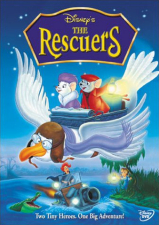 | ||
 |








